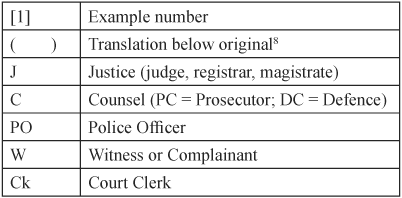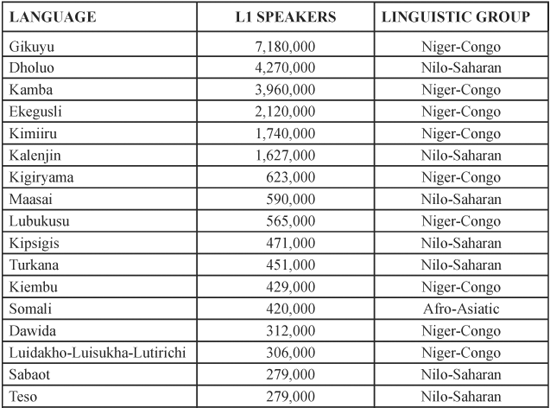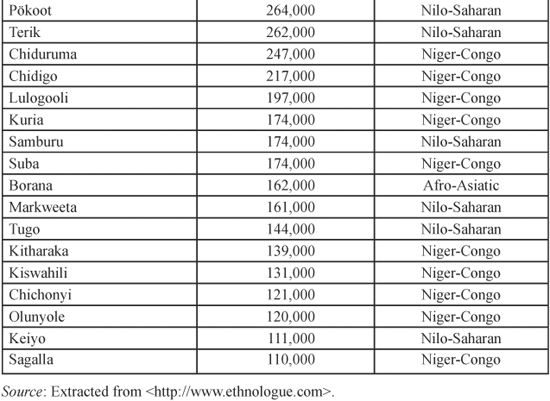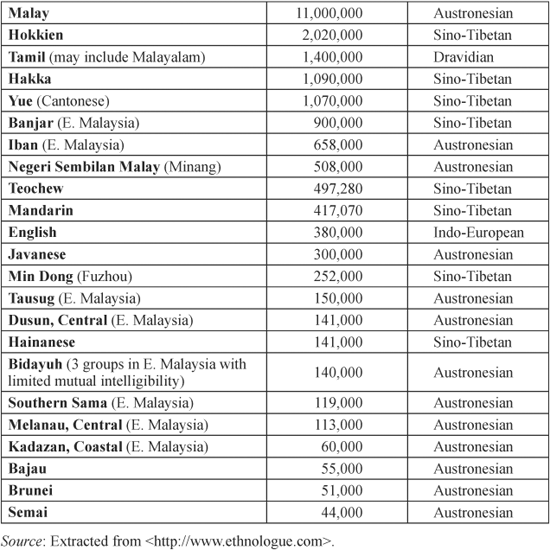Language Alternation in Kenyan and Malaysian Courts

Chapter 11
Language Alternation in Kenyan and Malaysian Courts
Introduction
Alternating between two or more languages is an unmarked communication choice for a large part of the world’s population. Labov (1971) concluded that this widespread practice is generally unsystematic and rule-free. However, numerous influential studies (for example, Poplack 1981; Gumperz 1992; Myers-Scotton 1999) have indicated that lexicogrammatical, pragmatic and sociocultural factors may constrain speakers’ propensity to alternate, even when there are few constraints on their personal proficiency in the languages in question. Such constraints may be reinforced by popular perceptions of language alternation as “broken” (Utusan 2004), or indicative of semilingualism rather than bilingualism, or somehow unsuited to formal situations. Further, domain-based macrolinguistic constraints may also add to the limitations of the immediate conversational context (Fishman 1972). There is also some evidence that formality inhibits language alternation—although Jacobson (2001) and David et al. (2009) found this inhibition to be much lower in Malaysia than in other sites they investigated.
Courts of law add further layers of restriction upon language choice, constituting one of the most formal of all sociolinguistic environments, with strict rules of speaking governing who says what to whom and when, often reinforced by official language policies governing which language(s) may be admitted in evidence. Whether for historical and institutional reasons or out of a desire to minimize ambiguity, most legal systems operate monolingually. Many multilingual societies, such as Botswana, prescribe the use of one language for the entire legal system. A smaller number, including Sri Lanka and Switzerland, recognize a number of court languages, but prohibit the mixing of different languages during the same proceedings. Even where there is no official prohibition, social and professional disapproval of mixing languages in formal situations are often reported.1 Discourse languages that are neither admitted nor tolerated by the court are invariably mediated by an interpreter, and it is the interpreted utterance rather than the original which is recorded. Courtroom code-mixing and code-switching, along with the admission of other languages without translation, are therefore of great interest for their comparative rarity and the insights they may bring to motivations for code choice.
Aims and Scope of this Study
This study compares language alternation in the courtrooms of two multilingual societies: Kenya and Malaysia. The former is in some ways typical of a great many postcolonial polities where law still functions largely in the medium of the former colonial administration, even though most citizens have limited proficiency in it. While there is little official acceptance of any language other than English in the legal system, code-switching with Kiswahili, the national language and main lingua franca, seems to occur quite frequently in courtroom discourse. Moreover, oral testimony in Kiswahili may be admitted without being translated into English. Malaysia offers us the more unusual case of an officially bilingual legal system. Other cases include Hong Kong, and to a lesser extent, Tanzania. Language planning in the 1980s and 1990s engineered a shift away from English toward the national language, Malay, but many judges continue to accept English, particularly in the higher courts and in commercial and civil matters. Testimony may be heard in either Malay or English without interpretation, and alternation between the two languages is very common.
Kenyan data for this study has been gathered from courtroom observations in a magistrates’ court in Central Nairobi (15 hours over ten days in 2009, with some additions from a similar period of observation in 2003). The Malaysian data was obtained from the Sessions Court in Petaling Jaya and the High Court in Shah Alam over three days in 2009, with additional examples from the Altantuya murder trial which took place in Shah Alam during 2008–2009, from Powell’s observations in a Kuala Lumpur High Court (in David et al. 2009), and from Noraini Ibrahim’s 2006 doctoral thesis on expert testimony. Courtroom data has been supported by documentary evidence (legislation, rules of procedure and so on) about language policy in the respective polities, and further informed by interviews with legal practitioners.
After summarizing the sociolinguistic and sociolegal situations of Kenya and Malaysia, a comparison will be made of the way in which languages are alternated in courtroom interactions in each country, focusing on the following patterns:
1. lexical code-mixing, where words from one language are embedded in utterances with a lexicogrammatical matrix largely drawn from another;
2. code-switching, in which a speaker juxtaposes clauses and whole sentences in different languages;
3. code-shifting, whereby a speaker uses one language with one interlocutor and a different language with another;
4. non-convergent dialogues, with two speakers conversing in separate languages and understanding each other without the help of an interpreter.
A second area for comparison is the motivation behind courtroom language alternation. Motivation is a notoriously evasive construct with regard to language alternation. Code-mixes made with local illocutionary intent can be hard to distinguish from habitual and unconscious loanwords. Intersentential code-switching may be significant when used sparingly, yet unremarkable when habitual and frequent. It is rarely possible to identify with any conviction the psychological, cultural, educational or performance-related factors that motivated a particular language choice in any given instance.
However, the courtroom is not a commonplace site of communication. Speakers—both experienced legal practitioners and witnesses appearing in court for the first time—are usually careful about what they say. Unlike in natural conversations, there is rarely more than one person talking at the same time, and the discourse progresses relatively slowly. This makes it reasonable to make intelligent guesses about the way in which speakers choose their words and also their code. In Malaysia, where code-switching is particularly frequent, courtroom interlocutors appear to switch languages not only to increase comprehension (as when lawyers show a preference for English among themselves, but for Malay with witnesses), but also for a number of convergence-, divergence- and performance-related reasons (such as clarification, emphasis, coercion and actual or metaphorical citation; for specific examples, see David 2003). Some of these motivations are apparent in Kenyan courtrooms as well. For example, defence lawyers routinely use English to gain an advantage over police witnesses who are less proficient in it, even after using Kiswahili quite competently in order to accommodate their own witnesses.
Drawing upon courtroom observations and interviews with legal practitioners, this comparative investigation shows how bilingualism in courtroom settings may yield insights into motivations for language alternation in general while shedding light upon the complex nature of legal discourse. Its findings suggest that even though language alternation is often used as a discursive weapon to coerce or isolate courtroom participants, it can also serve to make the workings of the law more transparent without sacrificing the interests of justice.
Sociolinguistic Context of Kenyan Law
Estimates of the number of languages spoken in Kenya range from 34 (Myers-Scotton 1993, 17) to some 60 (Ethnologue.com 2010) (see Table 11.1). Three major language families are represented: the Bantu branch of Niger-Congo, including Kiswahili; Gikuyu (or Kikuyu/Gikikuyu); Nilo-Saharan, which includes Dholuo (Luo) and Kalenjin, and Afro-Asiatic, including Cushitic languages such as Daholo. Although the last group is spread over wide territories, it includes few languages with as many as 100,000 speakers. Bantu speakers account for 66% of the country’s population (Myers-Scotton 1993, 19).
Table 11.1 Kenyan languages with over 100,000 reported speakers


Any information on language use must be considered in the light of a range of methodological and conceptual limitations, such as the language- and identity-awareness of speakers themselves. In the case of East Africa, there is also considerable variation in the classification of speech-groups as languages or dialects, with mutual intelligibility not necessarily being the deciding factor (Myers-Scotton 1993, 17). The above data nonetheless clearly indicate that Kenya, with a population of 38.5 million, has a degree of linguistic diversity higher than in most of central-southern Africa.
Crucial to this diversity, yet commonly overlooked in data-gathering, is the high level of multilingualism, with most speakers who have any regular contact with those outside their speech-community being fluent in at least one other language. Code-switching has been widely reported (for example, Myers-Scotton 1993). While the statistics indicate only 130,000 L1 speakers of Kiswahili, the language has wide vehicularity as a lingua franca. It is claimed to be spoken by some 70% of the population (Mazrui and Mazrui 1998), has had the status of national language since independence, and is one of the few indigenous languages with a considerable body of literature.2 As few as 24,000 claim English as their L1, yet the language, used widely both inter- and intra-ethnically, is spoken by up to 45% of Kenyans (Mazrui and Mazrui 1998) and is the medium of nearly all education except at early elementary level.
English emerged as the language of government and education on independence in 1963. While an educational report published soon after the Second World War proposed using the vernaculars in the first four grades of primary school (before switching to Kiswahili medium, with English to be introduced as a subject in grade five and as the main medium of instruction for secondary education), the following decade saw a steady erosion of the status of Kiswahili. In 1953—the year UNESCO promulgated the importance of mother-tongue instruction— English was made a compulsory subject in the primary school-leaving exams. In 1955, the report of the East Africa Royal Commission (Dow Report) expressed support for English, reflecting a shift in British colonial policy in the last decade of empire to ensure that the postcolonial rulers would be favorable to British interests. In general, English education was widely supported by Africans as well (Hargreaves 1996, 252). However, the nation’s first African leader, the Gikuyu-speaking Jomo Kenyatta, was well aware of the symbolic and nationalizing power of Kiswahili. He ended his first parliamentary speech in it in 1964, publicly described it in 1969 as the national language, and planned, against the opposition of his Attorney-General, to give it priority in parliamentary debate (Mazrui and Mazrui 1996, 293). His Minister of Information, Robert Matano, once threatened to fire bureaucrats lacking proficiency in the language. However, President Moi, from one of the smaller, non-Bantu groups (Tugen), restored English for debate in 1979, and there were no ministerial-level commissions or major reforms until 1985, when an 8-4-4 (8 years primary, 4 years secondary and 4 years higher) education structure was established, emphasizing the vernacular of the local area for the first four years, followed by English. Kiswahili was made a compulsory examination subject from the first grade. Increased enrolment in Swahili-language courses at Nairobi and Kenyatta Universities has been reported, and there is some evidence that the national language’s status has been rising, although it is not clear whether this has been at the expense of other vernaculars or English (Myers-Scotton 1993, 30).
While Kiswahili has made some inroads into the educational domain, it has had far less impact on the legal domain. Both Kiswahili and English are referred to as official languages. Article 53 (s.1) of the constitution states that the business of the National Assembly may be in English or Kiswahili, and s.34(c) requires candidates for the Assembly to be able to speak and read both languages. However, the constitution itself was drafted in English and as yet lacks an official translation in the national language. Laws and bills presented to parliament are in English.
The legal profession remains heavily anglicized, with legal training entirely in English, although the majority of lawyers now train in Kenya rather than the United Kingdom.3 Half of Kenya’s chief justices are foreign-born, and Ali and Alamnin Mazrui conclude that most Kenyans feel alienated from a judicial system that is “based on the assumption that many of the most senior judges might be completely illiterate in Kiswahili” (Mazrui and Mazrui 1998, 113). Lawyers routinely take oral depositions from clients in a vernacular, record it in English, explain what has been written, and then have them sign or thumb-print it.4 Constitutional Article 77(2)(f) states that a person charged with a criminal offence is permitted to have the assistance of an interpreter at the state’s expense, but there is no provision for the use of any language other than English in proceedings.
However, Kiswahili does have an important oral role. In the Nairobi High Court, signs are all in English, but some Kiswahili signs and notices can be found in the magistrates’ courts. Cases are announced first in English and then in Kiswahili. Court documents are exclusively in English, and conversation among lawyers and judges predominantly so—much of it never being translated for the benefit of defendants or witnesses. Verdicts, given in English, are often interpreted into Kiswahili by court clerks. Some judges, especially in the lower courts, routinely explain parts of the proceedings to defendants in Kiswahili,5 and the language may be used in oral evidence without translation.6 In general, oral examination tends to be in English in the High Court and for socially-higher ranking witnesses, but in Kiswahili in the lower courts and for less-educated witnesses. English was also used with socially higher-ranking witnesses in the Anwar case (see David 2003). Local-level police officers are required to be proficient in Kiswahili, but not English, and so defence lawyers often take advantage of them by insisting on questioning them in English when they give evidence in court.7
Sociolinguistic Context of Malaysian Law
Ethnologue.com lists 137 languages for Malaysia for a population of 26 million. Many of these are for speech communities of less than 20,000 speakers in rural areas of Borneo (see Table 11.2).
There are also large immigrant speech-communities, including the Rohingya, who number some 100,000. Standard Malay has been the national language since independence in 1957. An acrolectal form is taught in all schools, and is the main medium of instruction in state secondary schools. It is also used widely in meso-and basilectal varieties as a lingua franca between different ethnic communities. English is used for the teaching of some school subjects, and widely in tertiary education. It is an important lingua franca, especially in business and the professions. Bi- and tri-lingual code-switching is widely reported (for example, David et al. 2009).
Malaysia’s language policies and language politics continue to attract wide academic interest, particularly with regard to the educational domain. While the 1957 Constitution declared Malay the national language, English remained the main medium of government and education for the first decade of independence. In the 1970s, Malay was gradually phased into elementary, secondary and finally tertiary education. While English-medium schools were eliminated from the public sector, however, Mandarin- and Tamil-medium elementary schools were provided at elementary level as alternatives to Malay schools for the Chinese and Indian population (see David and Govindasamy 2005 and David 2004 for details of the language policy and effects on the education system). A provision for the Pupils’ Own Language to be taught as a school subject in areas with sufficient demand has also provided some support for languages such as Iban and Dusun. The policy of bringing Malay into the educational domain was reinforced by requiring high-school leaving qualifications in the language for anyone seeking government employment.
The subsequent rise in Malay proficiency across all ethnic groups has been accompanied, perhaps inevitably, by concerns about a decline in the standards of English, even though it has continued to be taught as a compulsory subject.
Table 11.2 Malaysian languages with over 50,000 reported speakers

In the 1990s there was a return to greater use of English at university level in order to address some of these concerns, and in 2002 the decision was made to teach mathematics and science (as well as English itself) in English at school level. Attitudes to this controversial move have been complex. Many Chinese educationalists feared a decline in standards of mathematics, which had been taught successfully in Mandarin, and negotiated a compromise for teaching subjects in both Mandarin and English. Some Tamil groups have seen the policy as offering greater opportunities to young Indians, while others would prefer the continuance of Tamil at elementary level and Malay at secondary. Some Malays in urban areas welcomed the change, while many in rural areas opposed it. Faced with wide dissatisfaction, in 2009 the government initiated the process of returning to the teaching of maths and science in Malay.
Following the phasing of Malay into the educational and administrative domains, a series of language reforms was launched in the 1980s to bring it into the legal domain. Malay was installed as the language of the courts, and required for proceedings and for documentary submissions. However, provision was made for the continuation of English where its use was deemed in the “interests of justice” (Constitution, Art. 152, Rules of the High Court 1980), and the language could continue to be used in testimony without being translated. These reforms enabled a rapid shift in the lower courts, where fewer witnesses and defendants are proficient in English, toward the national language. New laws are drafted bilingually. No language other than Malay or English may be used in court without interpretation. The right to an interpreter is provided for defendants and witnesses in criminal cases under Article 152 of the Constitution and also Clause 270(1) of the Criminal Procedure Code.
The result of the policy to promote Malay while allowing the continuation of English is a legal system in which either language may be used for most proceedings in most courts. Malay is more common in lower courts and criminal cases, in routine applications, and where the presiding judge was appointed from government service rather than from the bar. However, English continues to be used widely in the higher courts, and exclusively in the Federal (Supreme) Court. Judges are especially likely to exercise their discretion to allow English in civil and commercial cases and where legal arguments rely on judicial precedents. It is very common to find both languages used in the same proceedings.
Language Alternation in Courtroom Interactions
Identification, classification and analysis of language alternation is fraught with methodological and conceptual difficulties, including the construct of code itself, the possibility of differentiating between code-switches and established loans (a vain pursuit, according to Eastman 1992, 1), and the distinction between code-switching and code-mixing. The environment of courtroom conversation compounds these difficulties because of the prevalence of technical terms (which may be in Latin or French), citation of authorities (which may be written in a language different from the one being used in oral argument) and style-switching (for example, between more and less formal registers). Matters are not helped by the fact that the literature on courtroom language alternation is relatively sparse; this might reflect the rarity of the phenomenon itself, but more probably results from its under-reporting, since evidence for it has been found in a number of common law jurisdictions, including Malaysia (David 1993; David 2003; Powell 2008b), Botswana (Thekiso 2001), the United States (Angermeyer 2003) and Sri Lanka (Powell 2008a).
For the purposes of this study, the general term “language alternation” is used to cover code-mixing (the insertion of single words from one language into speech acts predominantly in another), code-switching (alternation of languages at phrase or clause level, both intrasententially and intersententially), code-shifting (changing from one language to another when there is a change of interlocutor) and non-accommodating dialogue (when interlocutors exchange speech acts in different languages without the intervention of an interpreter). While it is accepted that distinguishing loans from mixes is in practice difficult, and on occasions impossible, the distinction is nevertheless held to be useful when the use of certain words appears marked by others involved in the discourse. Similarly, the concept of discrete codes is itself held to be an important one, even though they may not easily be separated out in practice. When language alternation is extensive or habitual, there seems to be some validity in Gibbons’ (1987) concept of code-switching as a code in itself.
Code-mixing
Insertion of single nouns and short nominal phrases appears to be the most common pattern of language alternation in the Nairobi Magistrates’ Court data (see Table 11.3 for the transcription key). There seems to be a slight preference for embedding English within Kiswahili, rather than the other way around. Many of these English lexemes are legal terms used frequently by all main parties:

[1] J[to C]: Una witness yeyote?
(Do you have) (any)
[2] J: Una prefer upelekwe remand ama police station?
(You prefer) (to be taken to) (or)
D: Ndio , police station ni mzuri.
(Yes) (is good)
[3] C:Kesi yako itakuwa na mention on 6/8/2009.
(Case) (your) (will have)
[4] D: Magistrate alinipatia bond of 50, 000, but singeweza kulipa.
(gave me) (I could not) (pay)
Other common insertions, while not legal terms, have administrative connotations:
[5] C: Wakati polisi walienda, gari yako, ilikuwa na registration?
(When) (the police) (went) [to] (vehicle) (your), (it had)
[6] W: Hakuna authority ya kutoa anything bila mwangi kupeana ruhusa.
(There is no) (to remove) (without) (giving) (consent)
Quite often an English legalese code-mix precedes, and perhaps triggers, a clausal code-switch: